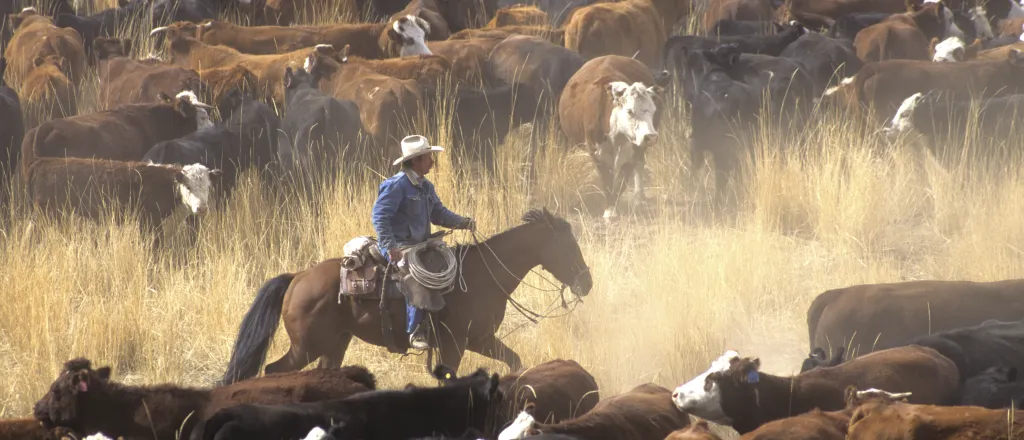
Transcript
[Music] Welcome to the Pasture to Profit podcast with Colorado State Extension's livestock specialist, Travis Taylor, and myself, Scott Stennett.
Travis, it's that time of year when we see ads in the paper, hear ads on the radio, get them in our mailboxes for bull sales.
Time to start buying bulls.
Bull catalogs are coming through.
The semen catalogs are coming in.
So, the question is, what's important to remember and to think about when selecting bulls for this year?
Well, Scott, I think the biggest thing we have to remember is what the genetic impact is of a bull in our herd.
I mean, 87 percent of the genetics in our herd can be attributed to the last three sire selections on a female basis.
She's pretty much made up of her last three sires, her daddy, her granddaddy, and her great granddaddy, if you want to say that.
And, another thing to think about is just how heritable some of the traits are.
I mean, when we're selecting sires, remember that things like birth weight and gestation length are up to 35 percent heritable.
The economic traits of weaning weight, mature cow size, and yearling weight are somewhere between 30 percent to 40 percent heritable.
Carcass traits are more highly heritable, being up to 50 percent heritable for marbling and rib eye area.
And, feed efficiency and gain are in that 45 percent heritable range.
And, then there's some other factors that are important.
Things like disposition of your cow herd and milk production in your cow herd are 20 percent heritable.
Then we have those things that are probably a lot less heritable, like conception rate and calving interval, which are affected immensely by nutrition.
So, their heritability of those traits is relatively low, as low as 5 percent.
So, kind of thinking along those things, before we go to the sale, how do we know these things, and how can we use tools to help in that selection process when we go to buy a bull?
Well, when we're going to sales today, we have two really different genetic indicators that we use in the beef industry.
And, the first is expected progeny differences, or EPDs.
Those EPDs are usually based within the breed, so they're segmented to the breed that they're representing.
In which case, an Angus EPD cannot be compared directly to a Charla EPD, or a Simitall EPD, or a Hereford EPD.
And, they're all based on information in the pedigrees in the data bank collected by all these associations.
So, they're usually expressed in either pounds, in terms of weaning weight or birth weight, inches, in terms of a rib eye area EPD, or scores, in terms of a longevity EPD, or something in that realm, where we score them based on how long they've been in the herd.
So, they're usually expressed in years, inches, pounds, some kind of performance thing that we can do there.
And, they do include an individual animal's performance.
The weaning weight of a bull will affect his EPD, but the weaning weight of that bull's sibling, or cousin, or another offspring out of that bull's sire that's in Virginia, will also be calculated into that EPD system.
So, it's truly a more inclusive look at the total genetic package.
So, EPDs are usually based on that individual animal.
And then, associations have gone to utilizing production indexes.
That's an index that would take these EPDs and put them into something that's based in, usually expressed in a dollar value in a lot of the breeds.
So, they'll take birth weight, and milk, and longevity EPDs, calculate them in a formula, and come out with a total dollars maternal, or a maternal index there that gives you an idea of the maternal value of a bull.
Those EPD, or those indexes, excuse me, indexes are ones that are usually for maternal, feedlot performance, carcass performance, and usually breeds have an overall combined index to try to help eliminate some of the needs to maybe just look at individual EPDs when you go to that sale.
So, when you open your catalog, you take a look at all the performance information that's there.
You'll see individual performance.
You'll see expected progeny differences, and you'll most likely see indexes.
And of all those, the index probably brings you the greatest genetic value to sort on primarily, and it's as a starting point for your bull buying selection.
So, Travis, with all these EPDs and indexes that are out there, as a producer, you get your catalog, or you're talking to your semen salesman, and they present to you this new, exciting bull that's going to be out.
And we see the numbers on these indices and on these EPDs are great, but we see that there's an accuracy that follows along with it.
Tell me about how that accuracy fits in with these EPDs and indices.
So, Scott, every new bull is unproven.
I mean, we're buying an unproven item.
Okay, so when we look at an accuracy level for a new, unproven yearling bull, we're probably looking at an accuracy that's 5 percent to 15 percent.
Okay, so that means we can buy that young bull, and we're going to take him home, and we're going to mate him.
And his EPDs will change in terms of that accuracy, depending on the performance of his offspring.
We can compare that to an AI-sired bull that's been bred to 80,000 different cows, and his accuracy for that EPD might be 0.9 percent or 90 percent on something like birth weight or on rib eye area.
So when we look at those two, yes, anytime we buy a young bull, we're not sure exactly how accurate those EPDs are.
But currently, they do not fluctuate tremendously on there.
So if I buy a bull, and calving ease is always one of the first ones they want to look at, so if I buy a bull with a birth weight EPD of less than zero, and his accuracy is 0.05, I am probably very comfortable saying that that bull will still be under zero, no matter what I breed him to, even at a 0.05.
So we can get those outliers to come in.
If you want to improve your accuracy, we have the ability to use genomics and genomic testing.
For a bull that has not been used, we can do a genomics test and increase the accuracy of those EPDs, particularly in breeds like Hereford's, Angus, Scimitals, Charlays, and improve the accuracy of that on a bull that has never been mated, based on the genomic profile that we get back.
So that would move that accuracy on an unproven bull from, say, 10 percent to 30 percent without him even having a calf.
So there are ways to balance that out within the breeders, and it's a good question when you're buying bulls to ask if they've been genomically tested.
A lot of times in the bull sale catalog, there are unproven sires, so we just know that those accuracies are probably going to be 15 percent or less on an unproven sire.
All right, so now we've kind of gone through.
We understand our heritabilities.
We understand our EPDs, our indexes that we're going to use.
We've got a target amount of accuracy that we want to fit in.
Then what is our goals when we're going in to buy these bulls that we're going to use?
Well, I think that gets back to sitting down and deciding what you want to do in your operation.
Am I somebody who's raising replacement-style females to sell to other producers?
I'm probably going to lean higher on my maternal indexes.
Am I a producer who buys all my replacements as bred cattle, and then I breed them to terminal sires and send all my calves to market?
I'm probably not terribly interested in a milk EPD on any of those heifers, and I'm probably more interested in what my gain ratios or my average daily gain and performance in the feedlot are going to be for my customers as well as myself.
Or maybe I'm that producer that's trying to do both, and I'm retaining those cattle clear to marketing them on a grid through the packing facility, and I'm going to really get paid on those highly heritable traits of rib eye area and marbling.
I'm going to want to make sure that I'm including some carcass EPDs into my selection, and for sure probably going to look over there at that total combined index and look for bulls that rank in the upper 25 percent of the breed if that's where my payday is.
I'm the farmer feeder that's just weaning calves and backgrounding them.
I'm going to look for some calves that are growth that come easy, and cows can have those calves with very little issues, and yet they grow and perform in the feedlot.
So I think to set up our goals, it depends on our operation.
I think the second thing we do is we make a list when we get that catalog of bulls that meet those goals.
We don't want to go to a sale and buy a bull that's not fulfilling our desired goals.
So make a list out of that sale catalog of bulls that meet your acceptable minimum standards there.
I think you can stop and take a look at those bulls, and we have buyer's remorse when we go to the sale and we buy a bull just because we're at the sale and we take him home, and he's not the bull we wanted.
So if he's not on your list, I don't recommend you buying him when you leave the sale.
The other thing is never forget about feet and leg structure.
It's important that those bulls will be sound.
Think about things like scrotal size and having at least a 34-centimeter scrotum at a year of age, particularly if we're keeping replacement females at them.
And I think these things will help you in terms of your budget and price when you go to a sale.
Because if I'm looking for terminal sires and I have mature cows and I can use a higher birth weight bull that has more growth, he's probably going to be more reasonable to buy than somebody who's looking for a heifer bull that's strictly calving ease and going to be put on heifers so that they can sleep at night.
So I think when you go in, everything gets affected by budget and price, but not every one of us in our operation need to be looking at that same bull.
The $10,000 bulls are the ones that fit all those scenarios, and everybody likes them.
But there are some bulls for less money that will still make a genetic improvement in your herd based on your goals and selection.
So what I'm hearing you say is make your list, trust your list, and go with it.
Don't just buy one for the sake of buying a bull because you need them.
Correct.
Make your list before you go.
Once you get there, make sure that that bull fits your desired structure and soundness criteria.
And don't go home with a bull you don't want because you'll never be happy with it.
All right.
Well, Travis, I think that's some great information we hope our producers will be able to use.
But if you have any questions about today's topic or you'd like to suggest a topic of discussion, feel free to contact Travis and I.
I can be reached here at the Kit Carson County Office at 719-346-5571.
And Travis?
You can reach me at the Yuma County Extension Office at 970-332-4151.
And again, thanks for listening and joining us here on Pasture to Profit.
And we hope to see you next time on our next podcast.
[Music]








